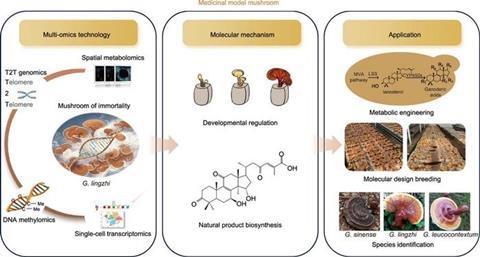A recent study published in Engineering has provided new insights into the spatiotemporal distribution and biosynthesis of ganoderic acids (GAs) in Ganoderma lingzhi (G. lingzhi), a mushroom renowned for its medicinal properties in traditional Chinese medicine.

The research, led by scientists from Northeast Forestry University, China, China Academy of Chinese Medical Sciences, and the University of Macau, utilized a multi-omics approach to map the distribution of GAs and elucidate their biosynthetic pathways.
READ MORE: Cures in crisis: vulnerable fungal species and their role in folk medicine
G. lingzhi, often referred to as the “mushroom of immortality,” has been used in traditional Chinese medicine for over 2000 years. It contains various bioactive substances, including polysaccharides, terpenoids, glycopeptides, nucleotides, and steroids, with ganoderic acids being particularly significant for their anticancer, anti-inflammatory, antioxidant, anti-aging, hepatoprotective, and nephroprotective properties. However, the biosynthetic pathway of GAs has remained poorly understood, limiting their large-scale commercialization.
Biosynthetic pathway
To address this gap, the researchers employed high-resolution matrix-assisted laser desorption/ionization mass spectrometry imaging (MALDI-MSI) to spatially map the distribution of GAs in both the primordium and fruiting body of G. lingzhi.
The study revealed that GAs predominantly accumulate in the shell of G. lingzhi, suggesting a role in environmental stress response. The Matrix-assisted laser desorption/ionization mass spectrometry imaging (MALDI-MSI) analysis detected 24 types of GAs, grouped into eight common molecular weight categories, with distinct accumulation patterns at different developmental stages.
In addition to MALDI-MSI, the researchers assembled the telomere-to-telomere (T2T) genomes of two haploid G. lingzhi strains, achieving the highest integrity and quality reported to date. The T2T genome assembly provided a complete and accurate genetic blueprint for analyzing the GA biosynthetic pathway. The study also constructed the first single-cell transcriptome atlas of the G. lingzhi fruiting body, identifying six distinct cell types and reconstructing the developmental trajectory of the shell.
Novel enzyme
A multi-omics analysis was used to annotate a novel cytochrome P450 enzyme (GlCYP512A3) involved in the oxidation of GA 3-hydroxy-lanosta-8,24-dien-26-oic acid (GA-HLDOA) into ganolucidic acids E and F. This finding is crucial for understanding the downstream oxidative modification steps in GA biosynthesis, which have been largely unknown due to the structural diversity of GAs.

The study’s comprehensive spatiotemporal multi-omics framework offers valuable insights into the molecular mechanisms mediating GA biosynthesis. The high-resolution mapping of GA distribution and the identification of key biosynthetic enzymes lay the foundation for future research on metabolic engineering and molecular breeding for high-yield and high-quality GA production.
The research was supported by the National Key Research and Development Program of China, the National Natural Science Foundation of China, and other funding sources. The findings not only enhance the understanding of GA biosynthesis in G. lingzhi but also provide a scientific basis for the development of new medicinal applications and cultivation practices to maximize GA yields.

No comments yet